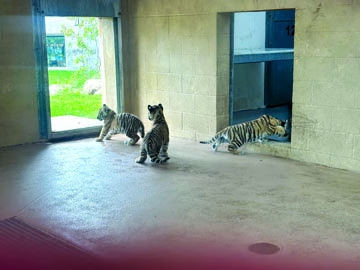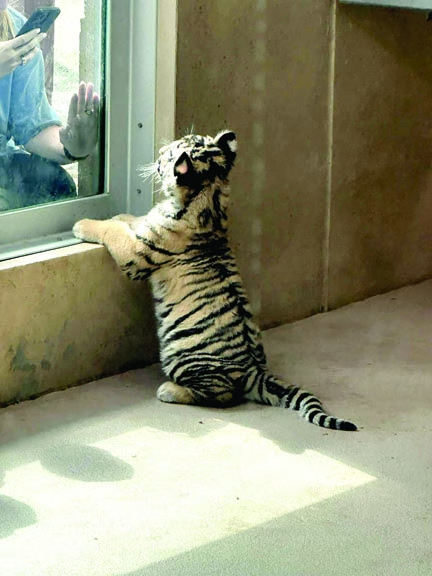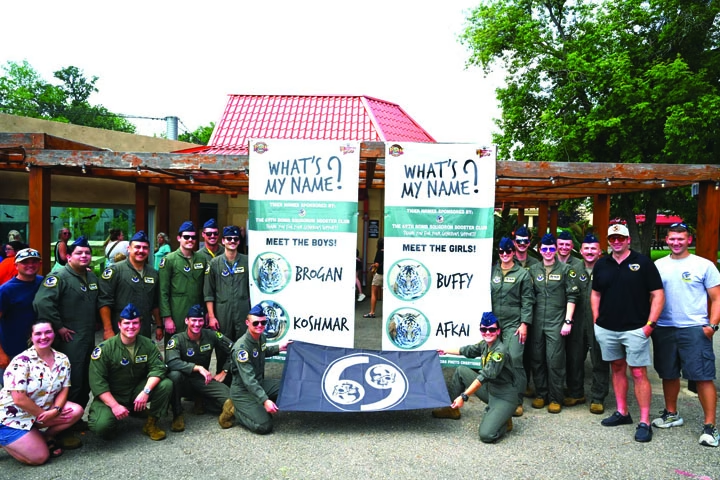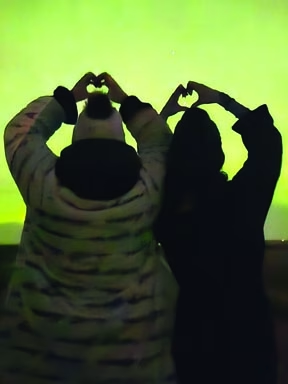It was a perfect North Dakota summer day – sunshine and a high of 75 with just the hint of a breeze. The sounds of laughter and the occasional cries of monkeys were reverberating around the Roosevelt Park Zoo. Scavenger hunts, crafts, and carousel rides were in full swing, drawing visitors on a merry chase across the grounds. Closer to 1:00 p.m. the crowd near the renovated Amur Tiger Habitat thickened. Individuals in flight suits began to appear, congregating in groups and drawing people closer with a gravitational pull all their own.

The occasion? The naming of the Zoo’s four Amur tiger cubs as part of its International Tiger Day Celebrations on 27 July. The men and women in uniform? Members of the 69th Bomb Squadron, also known as the Knighthawks. They had recently submitted the winning bids to name the zoo’s most popular additions and were present to reveal the results of their deliberations. Family and strangers alike gathered to watch. As two banners were unfurled and four names appeared, the crowd erupted in cheers. The cubs were officially christened: Buffy and Afkai for the females; Brogan and Koshmar for the males.
Representing the Knighthawks and presiding over the announcement and subsequent explanation of the names’ significance to their unit was Captain RJ “Whiz” Quandahl. He shared, “Buffy came from BUFF, the mighty B-52’s unofficial nickname. Afkai is a placeholder before aircraft receive their official callsigns on missions as well as a term we’ve adopted for use in the squadron to refer to certain members. ‘We make Nightmares,’ is the 69th Bomb Squadron’s slogan, and Koshmar is ‘nightmare’ in Russian. As for Brogan, I’ll keep it brief, but his name is one every B-52 aviator knows… He has done great things for our community, and we cannot thank him enough.” As the saying goes, if you know, you know.
When asked what inspired this plan Captain Quandahl said, “I believe one of our navigators, Captain Daniel “SNIPE” Hunt, was the first to see and share the post advertising the fundraising for their names. His message along with the initial support of our new flight surgeon Doctor Harrison Lee started it all. After that, we just had to make sure we had enough pledged donations to win all four.” Organized by their squadron booster club, all donations came from members’ personal funds. He noted that it was very much a team effort with nearly 40 individual donations and squadron members getting in on the spirit of things by donating amounts ranging from $69 on up – a wink at their unit’s numeric designation and an expression of squadron pride.
“The zoo has always been great to us, our families, and the community,” Captain Quandahl reflected, “As with many things in Minot, the zoo punches above its weight class, and the International Tiger Day festivities did not disappoint! I was not ready for that many families to show up. Speaking for myself here, but I was so glad to see others just as excited about these cute cubs as we were!”
Some of the most excited members of the squadron were in fact the spouses and children, who love being included in squadron events and unit heritage. Spouse Marian Weaver said, “It was really moving to see the members of the 69th Bomb Squadron and their families come together with the community of Minot to celebrate and name the baby tigers.” Her kids, while newer to the squadron, were quick to catch on to the excitement that a strong unit culture can generate.
Jacob Weaver, age 7, said, “My favorite tiger was Koshmar because it means ‘nightmare.’ It’s so awesome that the 69th Bomb Squadron got to name them.”
Sabrina Weaver, age 10, shared, “I liked the name Buffy because it’s cute and the scavenger hunt was really fun! We got to see all the animals.”
Minot AFB lore has overlapped with the Roosevelt Zoo’s before. In the 1960s when the 5th Fighter Interceptor Squadron or “Spittin’ Kittens” moved to the base, they acquired two Canadian lynx kittens. Appropriately named “Spitten” and “Kitten,” These were kept and bred on the base and became part of a private MAFB zoo. When the unit was finally de-activated, the remaining lynxes “Delta” and “Dart” were donated to the Roosevelt Park Zoo.
To learn more about this slice of base history, visit the Dakota Territory Air Museum where a display honors the men and women of the 5th Fighter Interceptor Squadron. Or participate in one of MAFB Library’s ‘History Walks,’ which feature interesting, lesser-known stories about the base, including the tale of its former zoo. The next history walk will take place on 8 August at 6:00 pm.














